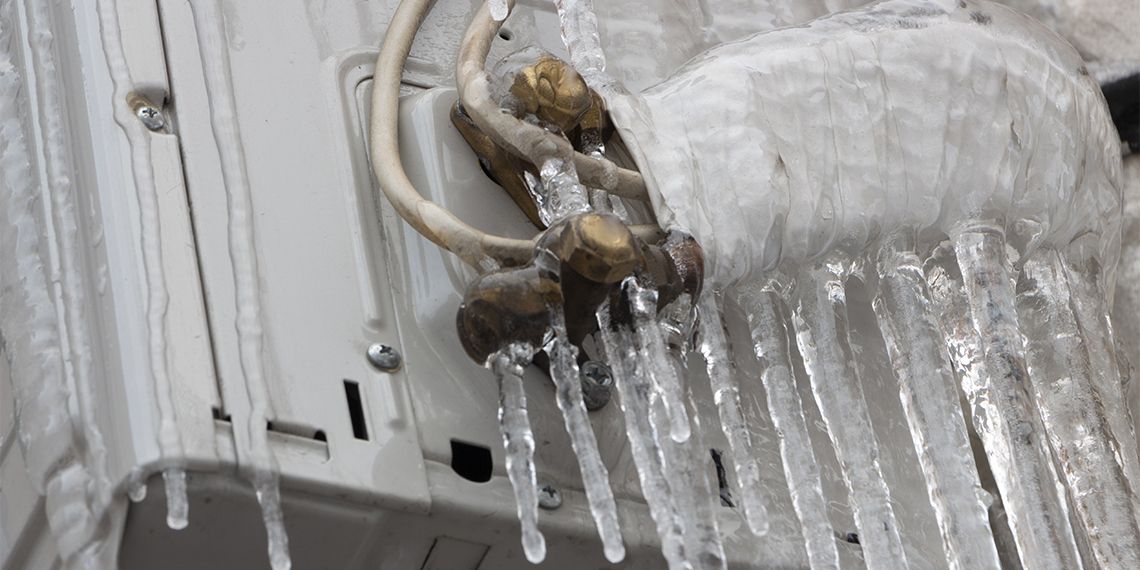Actions to Take When Your AC Pipe is Frozen: Detailed Manual
Actions to Take When Your AC Pipe is Frozen: Detailed Manual
Blog Article
We've come across this article involving Air Conditioner Frozen? How To Fix your Frozen AC Line listed below on the net and believe it made good sense to relate it with you over here.

Intro
Finding that your air conditioner pipe is frozen can be concerning, particularly throughout warm summer months when you count on your air conditioning unit the most. Understanding what to do in such a circumstance is critical to avoid additional damage to your cooling system and guarantee your comfort inside your home.
Recognizing the Causes
Numerous factors can add to the freezing of an air conditioner pipeline. Understanding these causes can aid you attend to the problem successfully.
Lack of Airflow
One common source of an icy air conditioner pipeline is inadequate airflow. When the airflow over the evaporator coil is restricted, it can create the coil to drop below freezing temperature, resulting in ice development on the pipeline.
Reduced Refrigerant Levels
Inadequate refrigerant degrees in your AC system can also result in a frozen pipe. Reduced refrigerant degrees can trigger the stress in the system to drop, resulting in the freezing of dampness on the evaporator coil.
Cold Weather Conditions
In colder environments, freezing temperatures outside can add to the freezing of air conditioner pipes. If your air conditioning system is not effectively insulated or if there are leakages in the ductwork, chilly air can penetrate the system, causing the pipeline to freeze.
Dirty Air Filters
Unclean or stopped up air filters can restrict airflow in your AC system, leading to different problems, including a frozen pipeline. It's necessary to change or clean your air filterings system on a regular basis to make certain proper airflow and prevent ice accumulation.
Signs of a Frozen AC Pipe
Identifying the indications of an icy AC pipeline is crucial for punctual action.
Lowered Airflow
If you observe a considerable decrease in air flow from your vents, it could indicate an icy pipe.
Ice Buildup on the Pipe
Visible ice buildup on the refrigerant line or the evaporator coil is a clear indicator of an icy AC pipeline.
Unusual Sounds from the Unit
Unusual sounds, such as hissing or gurgling, originating from your air conditioner system can signal that there's ice present on the pipe.
Immediate Actions to Take
When confronted with a frozen AC pipe, it's essential to act rapidly to stop more damage to your air conditioning system.
Shutting off the AC
The very first step is to switch off your a/c unit to avoid the system from running and aggravating the concern.
Checking for Blockages
Inspect the area around the indoor device for any type of blockages that might be blocking airflow, such as furnishings or drapes.
Defrosting the Pipe
You can use gentle techniques like putting towels taken in warm water around the frozen pipeline to aid thaw it gradually.
Safety nets
Taking preventive measures can aid prevent future occurrences of an icy AC pipe.
Routine Maintenance Checks
Arrange regular upkeep consult a professional HVAC professional to ensure that your air conditioner system is running efficiently.
Changing Air Filters
Routinely replace or cleanse your air filters to avoid airflow limitations and maintain optimum efficiency.
Insulating Exposed Pipes
If your air conditioning pipelines are subjected to cold temperatures, consider protecting them to prevent freezing throughout cold weather.
Looking For Professional Help
If DIY techniques fail to solve the problem or if you're unsure concerning just how to continue, it's finest to look for help from a certified HVAC technician.
When DIY Methods Fail
If your attempts to thaw the pipeline or address various other issues are not successful, it's time to call in a specialist.
Importance of Hiring a Professional HVAC Technician
A licensed HVAC specialist has the knowledge and tools necessary to diagnose and fix concerns with your a/c system securely and successfully.
Verdict
Dealing with an icy a/c pipeline can be a discouraging experience, however recognizing how to react can help reduce damage and bring back convenience to your home. By comprehending the reasons, recognizing the indicators, and taking timely action, you can efficiently address the problem and prevent future incidents.
G UP? HOW TO FIX IT?
It happens all over America. And the rest of the world probably. It’s the hottest day ever and for some darn reason your AC isn’t cooling the house. You fiddle with the thermostat to try and fix the problem. Nada. All you can do now is go outside and check the AC unit. You make your way there and find your air conditioner unit is frozen! But how?
In this post we’ll cover how you can tell that your air conditioner has frozen (other than the obvious reasons), what could have caused the freeze, and some of the things you can do about your AC freezing up. And if you have a frozen heat pump condenser, read our blog about it to learn what to do! But remember, it is always best to avoid your AC freezing up with an AC tune up. And if you are moving into a home, it's critical to get HVAC inspection so that you are aware of an AC problems before you move in.
Keep reading and you may be able to fix the frozen AC yourself. If you can’t, call an HVAC specialist. If you live in Maryland, call SuperTech HVAC for AC repair. We’ll take care of it.
How Does An Air Conditioning Unit Work?
How you probably imagine an AC works is wrong. Contrary to popular belief, an AC system does not inject cool air into a building. Instead, it removes the heat from inside and transfers it outside. Cool huh? (Pun intended).There are 4 major components among the 3 stations of an air conditioning system: the evaporator coil, the compressor, the condenser, and the refrigerant – a special chemical that links everything together through a closed loop system.
Station 1:
Warm indoor air is sucked into the return vent, through a filter, and blows over the evaporator coil. The heat is absorbed into the cold refrigerant, turning it from liquid to gas. The air, which is now cool, is blown back into the home to areas that your thermostat, i.e. you, has decided.
Station 2:
The refrigerant makes its way outside the house to the compressor, which squeezes the warm refrigerant, raising its gaseous temperature even more.
Station 3:
When the super hot vapor refrigerant reaches the condenser, the last step, the heat is expelled and absorbed into the outdoor air. The refrigerant instantly cools, which changes it from gas back to liquid form. The cold liquid refrigerant is now ready to return to station 1 and repeat the process.
Is Your AC Freezing Up? Here Are The Signs:
As you may have guessed, your air conditioner unit freezing up on a hot day is not normal.
If this happens, there's no need to panic. Often the issue can be solved with a little troubleshooting. If the AC unit is left frozen for too long however, you may find yourself with a bigger problem.
First things first, how do you know your AC is frozen?
Well, the obvious sign is the ice on your refrigerant line-set pipe. Simply check between your outdoor AC unit and your home's exterior wall to see whether your AC line frozen.
You might also have a frozen evaporator coil. This one's not as easy to check. You'll need to open a panel on the indoor unit to inspect. Don't do this unless you're handy. If you aren't, call an HVAC pro like SuperTech HVAC or you may damage something in the process.

We had been shown that write-up about Have a Frozen AC Line? Here’s How to Fix It from a good friend on another domain. Remember to set aside a second to distribute this write-up if you appreciated it. Thank you for your time invested reading it.
Click Here! Report this page